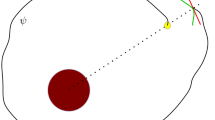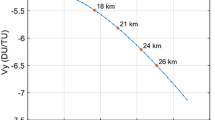Abstract
A novel Mars orbit insertion strategy that combines ballistic capture and aerobraking is presented. Mars ballistic capture orbits that neglect the aerodynamics are first generated, and are distilled from properly computed stable and unstable sets by using a pre-established method. A small periapsis maneuver is implemented at the first close encounter to better submit a post-capture orbit to the aerobraking process. An adhoc patching point marks the transition from ballistic capture to aerobraking, from which an exponential model simulating the Martian atmosphere and a box-wing satellite configuration are considered. A series of apoapsis trim maneuvers are then computed by targeting a prescribed pericenter dynamic pressure. The aerobraking duration is then estimated using a simplified two-body model. Yaw angle tuning cancels the inclination deflections owing to out-of-plane perturbation from the Sun. A philosophy combining in-plane and out-of-plane dynamics is proposed to simultaneously achieve the required semi-major axis and inclination. Numerical simulations indicate that the developed method is more efficient in terms of the fuel consumption, insertion safety, and flexibility when compared with other state-of-the-art insertion strategies.
Similar content being viewed by others
Change history
11 February 2022
A Correction to this paper has been published: https://doi.org/10.1007/s42064-022-0136-2
References
Battin, R. H. An Introduction to the Mathematics and Methods of Astrodynamics, Revised Edition. Reston, VA: AIAA, 1999.
Esposito, P., Alwar, V., Demcak, S., Graat, E., Johnston, M., Mase, R. Mars global surveyor navigation and aerobraking at Mars. In: Proceedings of the 13th International Conference on Space Flight Dynamics, 1998: AAS 98-112.
Topputo, F., Belbruno, E. Earth-Mars transfers with ballistic capture. Celestial Mechanics and Dynamical Astronomy, 2015, 121(4): 329–346.
Carrelli, D., O’Shaughnessy, D., Strikwerda, T., Kaidy, J., Prince, J., Powell, R. Autonomous aerobraking for low-cost interplanetary missions. Acta Astronautica, 2014, 93: 467–474.
Genova, A. ORACLE: A mission concept to study Mars’ climate, surface and interior. Acta Astronautica, 2020, 166: 317–329.
Spencer, D. A., Tolson, R. Aerobraking cost and risk decisions. Journal of Spacecraft and Rockets, 2007, 44(6): 1285–1293.
Lyons, D. T., Beerer, J. G., Esposito, P., Johnston, M. D., Willcockson, W. H. Mars global surveyor: Aerobraking mission overview. Journal of Spacecraft and Rockets, 1999, 36(3): 307–313.
Tolson, R. H., Dwyer, A. M., Hanna, J. L., Keating, G. M., George, B. E., Escalera, P. E., Werner, M. R. Application of accelerometer data to Mars odyssey aerobraking and atmospheric modeling. Journal of Spacecraft and Rockets, 2005, 42(3): 435–443.
Mazarico, E., Zuber, M. T., Lemoine, F. G., Smith, D. E. Atmospheric density during the aerobraking of Mars odyssey from radio tracking data. Journal of Spacecraft and Rockets, 2007, 44(6): 1165–1171.
Uesugi, K. Results of the MUSES-A “HITEN” mission. Advances in Space Research, 1996, 18(11): 69–72.
Lyons, D. T., Saunders, R. S., Griffith, D. G. The Magellan Venus mapping mission: Aerobraking operations. Acta Astronautica, 1995, 35(9–11): 669–676.
Serra, S. V., Bonnamy, O., Witasse, O., Camino, C. Venus express aerobraking. In: Proceedings of the 18th IFAC World Congress Proceedings, 2011: 715–720.
Smith, J. C. Jr., Bell, J. L. 2001 Mars odyssey aerobraking. Journal of Spacecraft and Rockets, 2005, 42(3): 406–415.
Graf, J. E., Zurek, R. W., Erickson, J. K., Jai, B., Johnston, M. D., de Paula, R. Status of Mars reconnaissance orbiter mission. Acta Astronautica, 2007, 61(1–6): 44–51.
Renault, H., Sergent, N., Chevallier, M., Kutrowski, N., Bacchetta, A., Temperanza, D. ExoMars 2016, Orbiter module bus a GNC development update. CEAS Space Journal, 2015, 7(2): 105–118.
Circi, C., Teofilatto, P. On the dynamics of weak stability boundary lunar transfers. Celestial Mechanics and Dynamical Astronomy, 2001, 79: 41–72.
Circi, C. Properties of transit trajectory in the restricted three and four-body problem. Advances in Space Research, 2012, 49(10): 1506–1519.
Jehn, R., Campagnola, S., García, D., Kemble, S. Low-thrust approach and gravitational capture at Mercury. In: Proceedings of the 18th International Symposium on Space Flights Dynamics, 2004: 487.
Mingotti, G., Topputo, F., Bernelli-Zazzera, F. Earth-Mars transfers with ballistic escape and low-thrust capture. Celestial Mechanics and Dynamical Astronomy, 2011, 110(2): 169–188.
Luo, Z. F., Topputo, F., Bernelli-Zazzera, F., Tang, G. J. Constructing ballistic capture orbits in the real Solar System model. Celestial Mechanics and Dynamical Astronomy, 2014, 120(4): 433–450.
Fantino, E., Gómez, G., Masdemont, J. J., Ren, Y. A note on libration point orbits, temporary capture and low-energy transfers. Acta Astronautica, 2010, 67(9–10): 1038–1052.
Luo, Z. F., Topputo, F. Analysis of ballistic capture in Sun-planet models. Advances in Space Research, 2015, 56(6): 1030–1041.
Bokelmann, K. A., Russell, R. P. Halo orbit to science orbit captures at planetary moons. Acta Astronautica, 2017, 134: 141–151.
Qi, Y., de Ruiter, A. Low-energy transfers to long-term capture in the Earth-Moon system. Acta Astronautica, 2018, 152: 836–849.
Luo, Z. F. The role of the mass ratio in ballistic capture. Monthly Notices of the Royal Astronomical Society, 2020, 498(1): 1515–1529.
Carletta, S., Pontani, M., Teofilatto, P. Dynamics of three-dimensional capture orbits from libration region analysis. Acta Astronautica, 2019, 165: 331–343.
Belbruno, E. A., Miller, J. K. Sun-perturbed Earth-to-moon transfers with ballistic capture. Journal of Guidance Control and Dynamics, 1993, 16(4): 770–775.
Camino, O., Alonso, M., Gestal, D., de Bruin, J., Rathsman, P., Kugelberg, J., Bodin, P., Ricken, S., Blake, R., Voss, P. P. et al. SMART-1 operations experience and lessons learnt. Acta Astronautica, 2006, 61(1–6): 203–222.
Hatch, S., Chung, M. K., Kangas, J., Long, S., Roncoli, R., Sweetser, T. Trans-lunar cruise trajectory design of GRAIL (gravity recovery and interior laboratory) mission. In: Proceedings of the AIAA/AAS Astrodynamics Specialist Conference, 2010: AIAA 20108384.
Elliott, J., Alkalai, L. Lunette: A network of lunar landers for in situ geophysical science. Acta Astronautica, 2011, 68(7–8): 1201–1207.
Schuster, A., Jehn, R. Influence of the Mercury gravity field on the orbit insertion strategy of BepiColombo. Aerospace Science and Technology, 2014, 39: 546–551.
Carbone, A., Cinelli, M., Circi, C., Ortore, E. Observing Mercury by a quasi-propellantless mission. Celestial Mechanics and Dynamical Astronomy, 2020, 132: 8.
Hyeraci, N., Topputo, F. Method to design ballistic capture in the elliptic restricted three-body problem. Journal of Guidance, Control, and Dynamics, 2010, 33(6): 1814–1823.
Archinal, B. A., A’Hearn, M. F., Bowell, E., Conrad, A., Consolmagno, G. J., Courtin, R., Fukushima, T., Hestroffer, D., Hilton, J. L., Krasinsky, G. A. et al. Report of the IAU working group on cartographic coordinates and rotational elements: 2009. Celestial Mechanics and Dynamical Astronomy, 2011, 109: 101–135.
Bertin, J. J. Hypersonic Aerothermodynamics. Washington, DC: AIAA, Inc., 1994.
Folkner, W. M., Williams, J. G., Boggs, D. H., Park, R. S., Kuchynka, P. The Planetary and Lunar Ephemerides DE430 and DE431. IPN Progress Report 42-196, 2014.
Circi, C., Teofilatto, P. Effect of planetary eccentricity on ballistic capture in the solar system. Celestial Mechanics and Dynamical Astronomy, 2005, 93(1–4): 69–86.
Luo, Z. F., Topputo, F. Capability of satellite-aided ballistic capture. Communications in Nonlinear Science and Numerical Simulation, 2017, 48: 211–223.
Hibbard, K., Glaze, L., Prince, J. Aerobraking at Venus: A science and technology enabler. Acta Astronautica, 2012, 73: 137–143.
Roy, A. E. Orbital Motion. Boca Raton: CRC Press, 2004.
Hyeraci, N., Topputo, F. The role of true anomaly in ballistic capture. Celestial Mechanics and Dynamical Astronomy, 2013, 116(2): 175–193.
Zhou, C. H., Liu, L. Time needed to use aerobraking to insert planetary low orbiters. Journal of Spacecraft TT&C Technology, 2013, 32: 438–443. (in Chinese).
Acknowledgements
This work was supported by the National Natural Science Foundation of China (No. 11602301), the Science and Technology Laboratory on Space Intelligent Control for National Defense (No. KGJZDSYS-2018-12), and the National Key R&D Program of China (No. 2019YFA0706601). We are grateful to Dr. Chen Zhang for supporting the numerical simulations and to Dr. Han-Lun Lei for providing helpful opinions.
Author information
Authors and Affiliations
Corresponding author
Additional information
Zongfu Luo was a visiting student of Politecnico di Milano during 2012–2014, and received his Ph.D. degree from National University of Defense University in 2015. Currently, he is an associate research fellow in Nanjing University. His current interests are spacecraft dynamics and control.
Francesco Topputo is an associate professor at the Department of Aerospace Science and Technology, Politecnico di Milano, where he received his Ph.D. degree. His core research activities involve spacecraft flight dynamics and control, interplanetary CubeSat mission and system design, autonomous guidance and navigation. In 2019, he became ERC laureate.
Rights and permissions
About this article
Cite this article
Luo, ZF., Topputo, F. Mars orbit insertion via ballistic capture and aerobraking. Astrodyn 5, 167–181 (2021). https://doi.org/10.1007/s42064-020-0095-4
Received:
Accepted:
Published:
Issue Date:
DOI: https://doi.org/10.1007/s42064-020-0095-4




